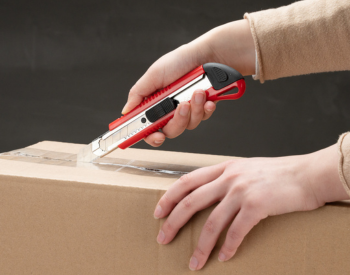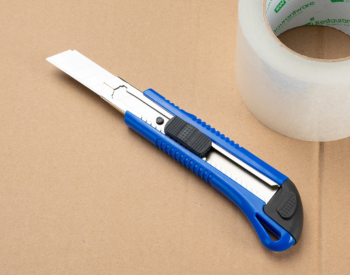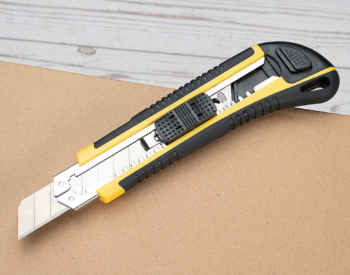The box cutter: a humble tool ubiquitous in workplaces around the world, from warehouses to home offices. Small, versatile, and highly efficient, it has become an indispensable aid in the handling of packaging materials. However, despite its seemingly straightforward usage, the box cutter is not without its risks. Without proper care, this tiny tool can cause serious injuries. Today, we will take a closer look at box cutter safety, unraveling the dos and don'ts to ensure safe handling.
Understanding The Risks
Box cutters, also known as utility knives, pose several hazards. Injuries can occur from accidental slips while using the tool, inadvertent contact with the blade, or even improper storage. Common injuries include lacerations, punctures, and even amputations. Understanding these risks underscores the importance of safety practices.
Proper Selection
Box cutter safety starts even before you pick up the tool—it begins with selecting the right one. Choose a box cutter designed with safety features, such as self-retracting blades, ergonomic handles, and blade guards. Some newer models even include technology that prevents the blade from cutting human skin. Investing in a high-quality, safety-focused box cutter can be the first step toward preventing accidents.
Safe Usage
Navigating the safe usage of box cutters is a cornerstone of maintaining safety in various work environments. This section outlines the best practices to employ when using a box cutter, focusing on knowledge of the tool, maintaining a correct grip, and adopting safe, cutting techniques. Let's delve into these critical safety guidelines to make every cut both efficient and safe.
Know Your Cutter
Before you start using your box cutter, familiarize yourself with its features. Know how to open and close it, and how to engage any safety features. If you're unsure, consult the manufacturer's instructions.
The Correct Grip
Hold the box cutter firmly with your dominant hand. Your fingers should be on the handle, not the blade slider, and never on the blade itself. Your grip should be such that you maintain complete control over the tool at all times.
Cutting Techniques
Always cut away from your body and others around you. A common mistake is pulling the cutter towards oneself, which increases the likelihood of an accident should the blade slip. Keep your free hand, and any other body parts, out of the cutting path. If you're cutting along a line, don't put your other hand down to stabilize the material unless it's a safe distance from the cutter.
When cutting, use smooth, continuous strokes rather than sawing back and forth. This helps prevent slips or sudden jerks that could cause an accident.
Blade Maintenance
Proper blade maintenance is essential for maintaining the functionality and longevity of a box cutter. Regular blade care ensures optimal cutting performance and helps prevent accidents. Start by cleaning the blade after each use. Use a soft cloth or paper towel to remove any debris, adhesive residue, or buildup from the blade. If the blade is excessively dirty or rusted, consider using a mild cleaning solution or rubbing alcohol for a more thorough cleaning. Once cleaned, make sure to dry the blade completely to prevent rusting. Additionally, it's crucial to periodically inspect the blade for any signs of wear or damage. If the blade becomes dull or chipped, it's time for a replacement to ensure safe and efficient cutting. Remember to handle the blade with care during maintenance, use appropriate protective measures such as gloves, and always follow the manufacturer's guidelines for your specific box cutter model. By practicing regular blade maintenance, you can keep your box cutter in excellent condition and enhance its performance for long-lasting use.
Safe Storage Of Box Cutters
When working with a box cutter or any kind of sharp blade, safety should always be a priority. The blade is inherently dangerous and can cause severe harm if not handled correctly. Therefore, it's important to make sure that when the box cutter isn't in use, the blade is always retracted. This helps reduce the risk of accidental cuts or injuries if someone were to inadvertently touch it.
Retracting the blade is a simple action, often involving just the push or slide of a button, yet it's a safety measure that can prevent a multitude of accidents. Unretracted blades can cut through material unintentionally, such as a bag or a pocket, which may lead to accidental harm. An exposed blade can also cause damage if it were to fall or if someone were to accidentally bump into it.
Furthermore, the box cutter should be stored in a designated, safe location after use. This location should ideally be out of reach of children and pets, or anyone not aware of its presence or not trained in its proper handling. By doing so, you minimize the chances of someone accidentally coming across it and potentially hurting themselves. It is advisable to keep it in a tool box, drawer or any other secure place where it can't cause unintentional harm.
Never leaving an open cutter unattended is another important rule. Even if you plan to be away for just a minute, it's crucial to close or retract the blade. This is because accidents can happen in the blink of an eye - a small child or pet could approach the open cutter, or someone could unknowingly place their hand or other body part near the blade.
Lastly, it is important to maintain proper blade cleanliness and sharpness. A dull or dirty blade can cause as much harm as a sharp one, possibly more because users tend to use more force with dull blades. Regular cleaning and replacement, as required, can ensure optimal performance and minimize chances of accidents.
Remember, while box cutters and other such tools are incredibly useful, they can be harmful if not treated with the respect and caution they deserve. By following these safety guidelines, you can ensure a safer environment for everyone.
Training & Awareness For Box Cutter Safety
Education is critical in maintaining a safe environment. Regular training sessions on box cutter safety can reinforce good habits and increase awareness of potential hazards. Encourage an open culture where employees feel comfortable reporting unsafe conditions or practices.
Quick First Aid For Box Cutter Injuries
Should an accident occur, a quick response can mitigate injury severity. Make sure you have a first aid kit nearby whenever you're using a box cutter. Familiarize yourself with basic first aid, such as applying pressure to stop bleeding, cleaning wounds, and when to seek medical attention.
Box cutters are undoubtedly valuable tools. But like any tool, they require careful handling to prevent accidents. By following these safety tips, you can use your box cutter confidently and safely. So, the next time you reach for that humble box cutter or utility knife, remember: safety is no accident.
When Using A Box Cutter, Should You Always Cut Away From You?
One of the cardinal rules when using a box cutter is always to cut away from your body. This simple yet crucial practice significantly reduces the risk of injury. When you cut toward yourself, you risk the blade slipping and causing an accidental injury, which could lead to severe lacerations. Cutting away from yourself, on the other hand, ensures that if the blade slips or if the material you're cutting suddenly gives way, the blade will move away from you, reducing the risk of harm. This is particularly important in workplaces where repetitive box opening is routine, as fatigue can increase the likelihood of slips or mishandled cuts. Maintaining the discipline to always cut away from your body, no matter how routine the task becomes, is a fundamental part of box cutter safety.
What PPE Is Needed For A Box Cutter?
Personal Protective Equipment (PPE) is a critical part of ensuring safety when using a box cutter. While the box cutter might seem like a simple tool, it can cause serious injury if mishandled, and PPE can provide a critical line of defense. At a minimum, cut-resistant gloves should be worn to protect your hands from accidental slips of the blade. These gloves are usually coated with materials like Kevlar or Dyneema, which can resist cuts without sacrificing dexterity. Safety glasses should also be considered to protect your eyes from any potential flying debris when cutting certain materials. Furthermore, if the task involves heavy boxes or items, wearing steel-toe boots can help protect your feet in case a box falls during the cutting process. Lastly, depending on the nature of the material being cut, a safety apron may also be advisable to protect the rest of your body. Remember, the goal of PPE is to provide a barrier between you and potential hazards.
Safety First!
Box cutter safety is a critical aspect that demands our attention, whether we're at the workplace or at home. Choosing a box cutter with safety features, understanding its operation, employing safe cutting techniques, maintaining the blade, storing the tool properly, and using appropriate Personal Protective Equipment (PPE) can significantly reduce the risk of injuries. Regular training and awareness sessions can further reinforce these practices and create a culture of safety. Always remember that with every cut, safety should be paramount. The humble box cutter, while a simple and effective tool, deserves respect and caution in its use. It's our collective responsibility to ensure every cut is a safe cut because, at the end of the day, safety is no accident.






